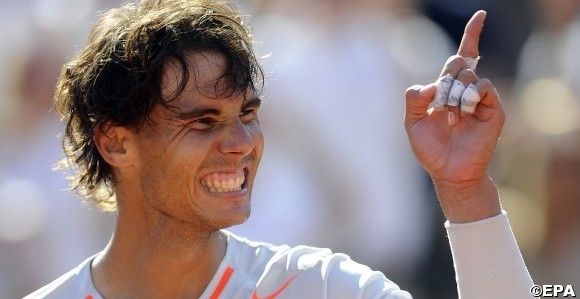The Story Behind Nadal’s Comeback
With Rafael Nadal back in place as the world no.1 after so many injury problems and many wondering whether he would ever be fully fit to contest at 100% again, questions are now understandably being asked on how the Majorcan managed to overcome his physical problems.
Today Britain’s Daily Mail has printed a large spread on the subject after reportedly speaking to both members of the Nadal camp and plus several independent medical experts, including an eminent knee surgeon. The newspaper comes up with the conclusion Nadal’s recovery is down to a combination of simple hard work, constant rehabilitation, two space-age training machines and the use of Plasma Rich Platelet (PRP) therapy, often known as blood-spinning.
PRP therapy, process, which involves taking blood and then re-injecting it around the knee tendons, is now entirely legal and in widespread use. Many other athletes from other sports have used the same technique, including golfer Tiger Woods.
However Nadal is insistent the claims are exaggerated, his knee are still an ongoing issue and he still plays matches in pain. “First of all, nothing used really worked great for me,” he said today as he prepared for his return to the Shanghai Rolex Masters. “PRP worked unbelievable on my knee before, in 2009 and 2010 after I had to pull out of Wimbledon.
“That injury I had was recovered 100% in very short period of time during the PRP treatment. But with the injury I have now, I tried lot of times and it really didn’t help me a lot. Seriously, we didn’t find the key of recovery and I need to keep working hard on finding things that will help me more.”
Nadal has won ten titles this year since returning to action in February following a seven months long layoff. However despite winning both the French and US Opens, having a 65-4 playing record and enjoying a 22 match winning streak until Novak Djokovic got the better of him in Sunday’s China Open final in Beijing, he insisted: “Since I came back, the feeling in the knee is not 100% perfect. But even if I have pain a lot of days, it’s not limiting my movements.
“Even if I have pain, I am able to control it; something in the past I was not able to do, and so I couldn’t play. For the moment, I am happy because I am able to play, but I would like to improve the feeling a little bit more.”
PRP therapy was banned by the World Anti-Doping Agency in 2010 due to fears it may have performance-enhancing effects similar to those involving larger transfusions. It was then made legal again at the start of 2011 as those fears receded due to the relatively small amount of blood involved. However recent research into PRP therapy suggests a by-product is the natural production of performance-enhancing Human Growth Hormone in the body.
During last year’s Wimbledon Championships, fellow Spaniard Fernando Verdasco gave an interview to the Wimbledon Live internet channel, outlining how he and Nadal had gone through the treatment together. Verdasco told interviewer Annabel Croft: “They take your own blood, they mix it and take the best part of your own blood, the best cells. Then they inject it in your tendon and with these injections you recover much faster.”
The Daily Mail article also uses Nadal’s trusted press and communications director Benito Perez-Barbadillo as a source when mentioning two gymnasium devices to try and help the 27 year-old overcome the tendinitis around his knees. One is a state-of-the-art contraption that controls, via computer, the exact amount of pressure being placed on muscle groups. The other a running machine that encloses the body from the waist down and creates an atmosphere, which lessens the pressure on joints.
However Nadal himself was insistent: “The machines I have at home, the only thing they help me is to make me a little bit more fit without having to run make an aggression on the tendon.”
Nadal also maintained, regardless of his success on hard court this season with title wins in Indian Wells, Montreal, Cincinnati and the US Open, he still regards the surface as potentially damaging to players’ long-term health.
“It doesn’t matter I am winning more on hard,” he said. “Nothing changes in my mind. I say it because it’s something that I think going to be fair for the next generations. If they are able to play in an easier surface for the body, to try to have a longer career, to try to be more healthy when they finish his careers. That’s something where probably I will not be that lucky.”
Topics: 10sballs, Atp, Fernando Verdasco, Rafael Nadal, Sports, Tennis, Tennis News, US Open, Wimbledon


10sBalls Top Stories
- Reasons Behind the Increase in Sex Shops
- Reasons Behind the Increase in Sex Shops
- Reasons Behind the Increase in Sex Shops
- Casibom: Yaşayan Casinolar ve Bahisler Lider Platform
- Sea Star Casino: Play Games Without Registering Online
- JETZT DEN SWEET BONANZA SLOT GRATIS DREHEN
- Азартные игры с Мостбет Казино – испытайте удачу
- Çevrimiçi en iyi yuvalar: Hizmetinizde Karavan Bet Casino
- Top No Deposit Free Spins Offer for Canadians – December 2024
- Abe Bet Casino: Ücretsiz dönüşlerle heyecan hissedin
- Ünlü slotlar çevrimiçi kumarhanelerde başarı bet giriş ücretli formatta
- BasariBet Casino Giriş – En Güzel Canlı Casino Oyunlarına Katılın
- Игра на деньги в казино 1вин казино: безопасность
- De parking de credits sans oublier les Diction Casino Archive sauf que Perception
- Играть в хитовые слоты в надежных клубах azino777





 The Story Behind Nadal’s Comeback
The Story Behind Nadal’s Comeback